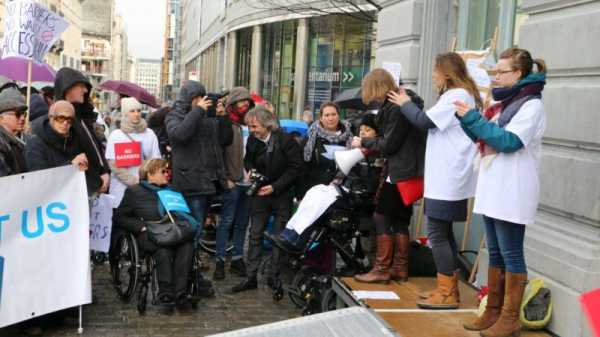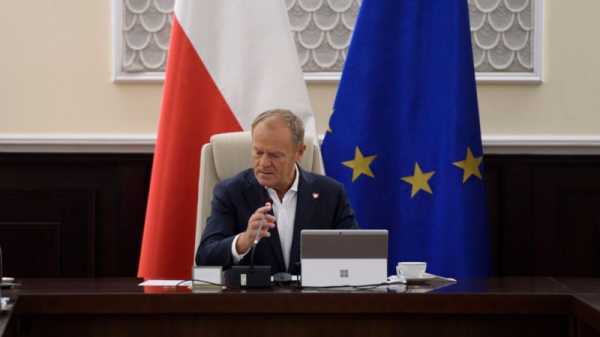
Persons with disabilities do not have an equal access to the Conference on the Future of Europe (CoFoE), writes Yannis Vardakastanis.
Yannis Vardakastanis is the president of the European Disability Forum and a member of the CoFoE Plenary.
This problem makes the CoFoE democratic exercise not different from other activities of our day-to-day life: it is harder, not very accessible and largely overlooks our needs, not to mention the diversity of our societies. There are many parts of life where persons with disabilities cannot participate on an equal basis with others. Sadly, this is also the case for this unprecedented democratic exercise, an initiative that has not achieved the inclusion we need for Europe.
The Conference on the Future of Europe is meant to be discrimination-free and democratic, focusing on citizens’ ideas. There are 100 million of us in the EU with a disability, and we have a lot to say. some of us are denied the right to vote (approximately 400,000 people in the last EU elections); we are discriminated when it comes to employment, education, and healthcare. We are more affected by the climate change consequences, and we are often forced to live in segregated residential institutions with no choice over how we lead our lives. We could raise these issues and many more, only if the Conference would fully include us.
Lack of inclusion
The first step should have been to ensure a broader and more diverse representation in the citizens’ panels. The Conference claimed the panels would be representative of Europe’s diversity, ensured by randomly selecting citizens. In the end, the method they used was to reach out to people by phone, excluding deaf and hard or hearing people who use written communication or sign language.
We are 15% of the EU’s population, but the Conference does not proportionally reflect this in citizens’ panels. We cannot be sure because there is no actual data on whether the panels include people from the most marginalised communities. Still, at the very least, we are aware that there has not been a dedicated effort to reach out to these groups.
Barriers
What we are also specific, is that the Conference is full of accessibility barriers, some of them small, others quite significant. Regardless of the magnitude of the barriers, in one way or another, they are all having the same impact. Obstacles are preventing persons with disabilities from engaging in the Conference. One example of a small barrier is the inaccessible CAPTCHA you must complete to register for a meeting. For those of us who are blind or partially sighted, this means you have to ask somebody to help you insert the code. Because of this easily fixable problem, we cannot be independent.
The multilingual digital platform
Bigger accessibility barriers can be found in one of the most crucial tools for the functioning of the Conference: its website, the multilingual digital platform, from which any citizen can submit and comment on other ideas discussed in the citizens’ panels and the plenary. Despite the EU has policies and technical standards on web accessibility, which should have ensured this platform being accessible from the very beginning, again we feel we are not welcome.
To help the Conference secretariat and the web team, the European Disability Forum commissioned an accessibility audit from a specialised company to assess and highlight the problems with the platform. The test revealed that persons using assistive technologies such as screen readers, or those who rely on keyboard navigation because of a motor disability, simply cannot use the website. In addition, the forms to add content via the platform are not properly designed. Also, some error messages are only displayed with colours, making it difficult for those with colour blindness. For instance, some buttons do not have enough contrast to be seen by a person with low vision.
We sent organisers this technical report, including recommendations on how to solve the problems back in September, and they reply that they might fix by January, three months before the end of the Conference.
It is also hard to follow the debates: public meetings have no live subtitling or sign language interpretation. As a matter of fact, even some of the pre-recorded promotional videos do not include these basic accessibility features.
Web accessibility
Another easily fixable issue is to provide materials in accessible formats, instead of using very lengthy, difficult, and inaccessible PDFs. If the Conference truly wants to reach out a wider audience, we would recommend following the example of the European Commission evaluation of the Web Accessibility Directive (one of the pieces of EU legislation laying down requirements for websites to be accessible). In this case, the Commission provided an easy-to-read set of questions, void of any EU jargon, and presented the whole thing in easy-to-understand language, and without requiring users to log to complete it. As a result, most of the users, including those without disabilities, opted for this format when responding, even though it was originally intended only for people with intellectual disabilities. Once again, as this example goes to show, accessibility is not only crucial for persons with disabilities but also beneficial to all. Imagine how many more EU citizens might engage in the Conference if they could easily understand all the information and materials.
Despite all difficulties, the European Disability Forum will keep on doing its best to bring the voices and ideas of persons with disabilities to the heart of this Conference. The future we want for Europe is inclusive and, to achieve this, the Conference should become a truly collaborative process that actively ensures everyone can participate.
Source: euractiv.com



